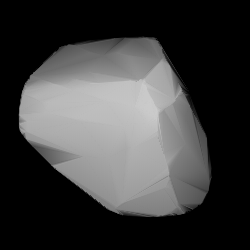Astronomy:104 Klymene
 3D convex shape model of 104 Klymene | |
| Discovery | |
|---|---|
| Discovered by | James Craig Watson |
| Discovery date | 13 September 1868 |
| Designations | |
| (104) Klymene | |
| Pronunciation | /ˈklɪmɪniː/[2] |
| A868 RB, 1893 FA 1951 OE, 1968 OS[1] | |
| Minor planet category | Main belt |
| Orbital characteristics[3] | |
| Epoch 31 July 2016 (JD 2457600.5) | |
| Uncertainty parameter 0 | |
| Observation arc | 130.58 yr (47693 d) |
| |{{{apsis}}}|helion}} | 3.6499 astronomical unit|AU (546.02 Gm) |
| |{{{apsis}}}|helion}} | 2.65525 AU (397.220 Gm) |
| 3.15256 AU (471.616 Gm) | |
| Eccentricity | 0.15775 |
| Orbital period | 5.60 yr (2044.5 d) |
| Average Orbital speed | 16.67 km/s |
| Mean anomaly | 101.498° |
| Mean motion | 0° 10m 33.888s / day |
| Inclination | 2.7905° |
| Longitude of ascending node | 41.698° |
| 32.134° | |
| Earth MOID | 1.66901 AU (249.680 Gm) |
| Jupiter MOID | 1.63907 AU (245.201 Gm) |
| TJupiter | 3.186 |
| Physical characteristics | |
| Dimensions | 123.68±3.1 km |
| Mass | 2.0×1018 kg |
Equatorial surface gravity | 0.0346 m/s2 |
Equatorial escape velocity | 0.0654 km/s |
| Rotation period | 8.984 h (0.3743 d) |
| Geometric albedo | 0.0568±0.003 |
| Physics | ~157 K |
| C | |
| Absolute magnitude (H) | 8.27 |
Klymene (minor planet designation: 104 Klymene) is a large, dark Themistian asteroid that was discovered by J. C. Watson on September 13, 1868, and named after one of the many Clymenes in Greek mythology.[4] It is orbiting the Sun with a period of 5.60 years and an eccentricity of 0.16. The orbital plane is inclined by 2.8° to the plane of the ecliptic. It is classified as a C-type asteroid, indicating it probably has a carbonaceous composition. The spectra indicates the presence of aqueous-altered minerals on the surface[5] based upon a sharp feature at a wavelength of 3 μm, and, as of 2015, is the only member of the Themis family found to show this absorption.[6]
Based upon measurements made using adaptive optics at the W. M. Keck Observatory, this object may have a bi-lobed shape with a length of 163 ± 3 km and width of 103 ± 5 km, for an average dimension of 133 km.[7] This asteroid is located near the region of the Themis family but itself considered a background asteroid using HCM-analysis.[8] It is listed as a member of the Hecuba group of asteroids that orbit near the 2:1 mean-motion resonance with Jupiter.[9]
104 Klymene has been observed to occult 6 stars between 2009 and 2023.
References
- ↑ Bowen, Eliza A. (1893), "Visualizing the Earth's annual motion", Popular Astronomy 1: 178–179, Bibcode: 1893PA......1..178B.
- ↑ Noah Webster (1884) A Practical Dictionary of the English Language
- ↑ Yeomans, Donald K., "104 Klymene", JPL Small-Body Database Browser (NASA Jet Propulsion Laboratory), https://ssd.jpl.nasa.gov/sbdb.cgi?sstr=104, retrieved 12 May 2016.
- ↑ Dictionary of minor planet names, International Astronomical Union. Springer, 2003, p. 25
- ↑ Fornasier, S. et al. (February 1999), "Spectroscopic comparison of aqueous altered asteroids with CM2 carbonaceous chondrite meteorites", Astronomy and Astrophysics Supplement Series 135 (1): 65–73, doi:10.1051/aas:1999161, Bibcode: 1999A&AS..135...65F, https://aas.aanda.org/10.1051/aas:1999161/pdf.
- ↑ Hargrove, Kelsey D. et al. (July 2015), "Asteroid (90) Antiope: Another icy member of the Themis family?", Icarus 254: 150–156, doi:10.1016/j.icarus.2015.03.008, Bibcode: 2015Icar..254..150H.
- ↑ Marchis, F. et al. (November 2006), "Shape, size and multiplicity of main-belt asteroids. I. Keck Adaptive Optics survey", Icarus 185 (1): pp. 39–63, doi:10.1016/j.icarus.2006.06.001, PMID 19081813, Bibcode: 2006Icar..185...39M.
- ↑ Moore, Patrick; Rees, Robin, eds. (2011), "Patrick Moore's Data Book of Astronomy", Patrick Moore's Data Book of Astronomy by Patrick Moore and Robin Rees. Cambridge University Press (Cambridge University Press): 165, ISBN 9781139495226, Bibcode: 2011pmdb.book.....M, https://books.google.com/books?id=2FNfjWKBZx8C&pg=PA165.
- ↑ McDonald, Sophia Levy (June 1948), "General perturbations and mean elements, with representations of 35 minor planets of the Hecuba group", Astronomical Journal 53: p. 199, doi:10.1086/106097, Bibcode: 1948AJ.....53..199M, http://adsabs.harvard.edu/cgi-bin/nph-data_query?bibcode=1948AJ.....53..199M&link_type=ARTICLE&db_key=AST&high=.
External links
- 104 Klymene at AstDyS-2, Asteroids—Dynamic Site
- 104 Klymene at the JPL Small-Body Database
 |

